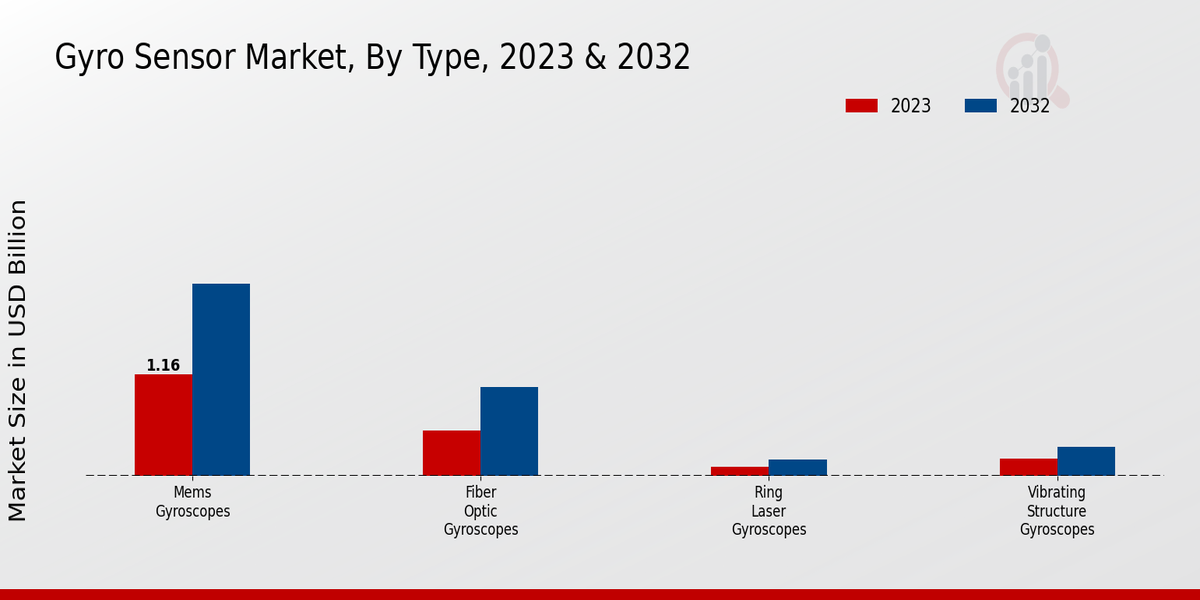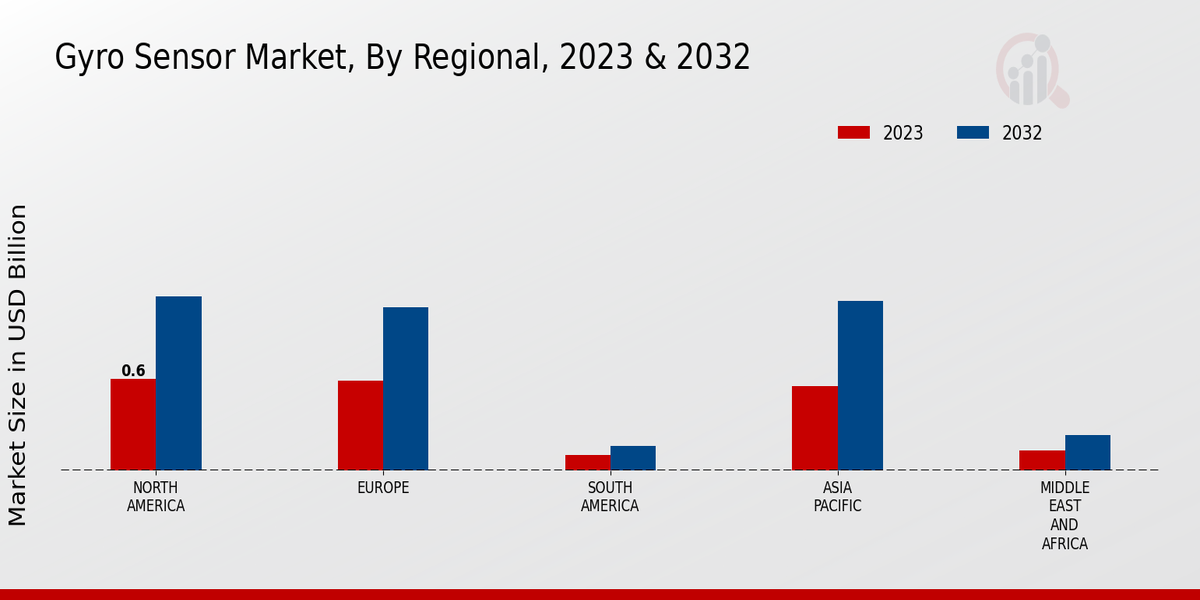Global Gyro Sensor Market Overview:
Gyro Sensor Market Size was estimated at 2.26 (USD Billion) in 2024. The Gyro Sensor Market Industry is expected to grow from 2.43 (USD Billion) in 2025 to 4.60 (USD Billion) till 2034, exhibiting a compound annual growth rate (CAGR) of 7.35% during the forecast period (2025 - 2034).
Key Gyro Sensor Market Trends Highlighted
The key market drivers in the gyro sensors market include the growing inclination towards the implementation of inertial navigation systems (INS) in end-uses, as in the case of autonomous vehicles, drones, and wearable devices. Furthermore, the market growth is driven by the need for improved stability and accuracy in consumer electronics. Growth in microelectromechanical systems (MEMS) technology has helped build smaller, cheaper, and more efficient gyro sensors.
Among the opportunities available in the gyro sensor market is the combination of these sensors with other technologies, such as accelerometric and magnetometric sensors in order to produce robust inertial measurement units. Further, the rapid uptake of augmented and virtual reality (AR/VR) applications is likely to create the need for gyro sensors.
Recent changes that have been observed in the gyro sensor market include the production of more sensitive, high-definition, and broad-banded high-performance sensors. The responsiveness of gyro sensors integrated with sophisticated algorithms and software is creating new applications such as gesture detection and motion sensing.

Source: Primary Research, Secondary Research, MRFR Database and Analyst Review
Gyro Sensor Market Drivers
Advancements in Consumer Electronics
The rising usage of advanced consumer electronics, including smartphones, tablets, and wearable devices, is a key factor driving the development of the gyro sensors market because these devices require gyro sensors for tracking motion, image stabilization, and navigation. Additionally, the consumption of gyro sensors in consumer electronics is expected to grow due to the rising demand for AR and VR applications. Overall, as the technology continues to develop, gyro sensors will be increasingly integrated into different types of consumer electronics, which will contribute to the growth of the entire market.
Autonomous Systems and Robotics
Autonomous systems and robotics are on the rise, thereby offering a substantial opportunity for the gyro sensor market. Gyro sensors are essential for autonomous navigation since they serve to provide orientation and angular velocity measurements reliably. With the development of more intricate autonomous vehicles and robots, the demand for reliable and high-performance gyro sensors is expected to grow. Gyro sensors find increasing demand as various industries, such as transportation, logistics, and healthcare, adopt autonomous systems.
Industrial Applications
Industrial applications such as manufacturing, construction, and mining fields are currently using gyro sensors in motion control, vibration monitoring, and stabilization in industrial machinery and equipment. Furthermore, with the increasing demand for automation and efficiency in industrial processes, the use of gyro sensors is expected to rise. Additionally, the implementation of Industry 4.0 technologies such as the Internet of Things and robotics will also increase the use of gyro sensors in industrial applications.
Gyro Sensor Market Segment Insights:
Gyro Sensor Market Type Insights
The Gyro Sensor Market is segmented by Type into MEMS Gyroscopes, Fiber Optic Gyroscopes (FOGs), Ring Laser Gyroscopes (RLGs), and Vibrating Structure Gyroscopes (VSGs). MEMS Gyroscopes held the largest market share in 2023, and are expected to continue to dominate the market over the forecast period. This is due to their low cost, small size, and low power consumption. MEMS gyroscopes are used in a wide range of applications, including smartphones, tablets, and drones. Fiber Optic Gyroscopes (FOGs) are expected to grow at the highest CAGR over the forecast period.FOGs are more accurate and reliable than MEMS gyroscopes, but they are also more expensive. FOGs are used in a variety of high-end applications, such as navigation and guidance systems. Ring Laser Gyroscopes (RLGs) are the most accurate and reliable type of gyro sensor. However, they are also the most expensive. RLGs are used in a variety of high-end applications, such as aircraft and spacecraft navigation systems. Vibrating Structure Gyroscopes (VSGs) are a relatively new type of gyro sensor. VSGs are less accurate than MEMS gyroscopes and FOGs, but they are also less expensive.VSGs are used in a variety of low-end applications, such as robotics and industrial automation. The Gyro Sensor Market is expected to grow from USD 2.28 billion in 2023 to USD 4.03 billion by 2030, at a CAGR of 7.9% over the forecast period. The growth of the market is attributed to the increasing demand for gyro sensors in various applications, such as smartphones, tablets, drones, and navigation systems.

Source: Primary Research, Secondary Research, MRFR Database and Analyst Review
Gyro Sensor Market Application Insights
The 'Gyro Sensor Market' segmentation by Application includes consumer electronics, automotive, aerospace defense, industrial, and medical sectors. Consumer electronics, with its high demand for motion sensing in smartphones, gaming consoles, and virtual reality devices, held the largest market share in 2023 and is expected to maintain its dominance throughout the forecast period. The automotive segment, driven by advancements in autonomous driving and vehicle safety features, is projected to grow significantly, reaching a valuation of USD 870.4 million by 2024.Aerospace defense applications, including navigation and stabilization systems in aircraft and missiles, are expected to contribute to the growth, while industrial and medical applications are also anticipated to witness steady growth due to increasing automation and healthcare advancements.
Gyro Sensor Market Output Insights
The Gyro Sensor Market is segmented by Output into Analog and Digital. The Digital segment is projected to dominate the market in 2023, accounting for around 60% of the Gyro Sensor Market revenue. This dominance is attributed to the increasing adoption of digital gyroscopes in various industries, including consumer electronics, automotive, and industrial automation. Digital gyroscopes offer advantages such as higher accuracy, precision, and reliability compared to analog gyroscopes. The Digital segment is also expected to witness significant growth in the coming years, driven by the increasing demand for digital gyroscopes in autonomous vehicles, drones, and other advanced applications.
Gyro Sensor Market Technology Insights
The technology segment plays a vital role in shaping the Gyro Sensor Market revenue, with different technologies offering unique capabilities and catering to specific applications. Capacitive technology stands out with a significant market share due to its ability to measure angular velocity and acceleration accurately. Piezoelectric technology offers advantages in high-temperature and harsh environments, making it suitable for industrial applications. Thermal technology provides low-cost options but with lower accuracy compared to other technologies.Magnetic technology is gaining traction in applications requiring precise and reliable angular measurements. The Gyro Sensor Market segmentation based on technology provides insights into the market dynamics, helping stakeholders make informed decisions and identify growth opportunities in the industry.
Gyro Sensor Market Regional Insights
The Gyro Sensor Market is segmented into North America, Europe, APAC, South America, and MEA. The market in North America is expected to grow at a CAGR of 7.5% during the forecast period, owing to the increasing adoption of gyro sensors in various applications, such as automotive, consumer electronics, and healthcare. The market in Europe is expected to grow at a CAGR of 7.2% during the forecast period, owing to the increasing demand for gyro sensors in the automotive and industrial sectors. The market in APAC is expected to grow at a CAGR of 8.2% during the forecast period, owing to the growing adoption of gyro sensors in smartphones, tablets, and other consumer electronics devices.The market in South America is expected to grow at a CAGR of 6.8% during the forecast period, owing to the increasing demand for gyro sensors in the automotive and industrial sectors. The market in MEA is expected to grow at a CAGR of 7.9% during the forecast period, owing to the increasing adoption of gyro sensors in various applications, such as automotive, consumer electronics, and healthcare.

Source: Primary Research, Secondary Research, MRFR Database and Analyst Review
Gyro Sensor Market Key Players And Competitive Insights:
Key players are constantly making significant investments in research and development to gain a competitive advantage. Leading players are developing innovative products and expanding their product portfolio to cater to the diverse needs of their customers. The gyro sensor market is witnessing a trend of the miniaturization of sensors and integration with other parts, leading to a compact, cost-effective device. Strategic partnerships and collaboration among major players in the gyro sensor market are on the rise to improve market reach and leverage technical expertise.
One of the major companies operating in the Gyro Sensor Market is Analog Devices, Inc. The company is already established in the global market and offers a high-performance range of MEMS-based motion sensors that comprise a gyroscope. The major focus of the company is on the development of highly efficient sensors that run on low power and yet deliver high accuracy. Analog Devices offers a large variety of software and support tools that will aid the development and integration of sensors. The company already enjoys strong brand equity and an established distribution channel; therefore, it is the leader in the gyro sensor market.STMicroelectronics is another competitor operating in the Gyro Sensor Market, which focuses on the objectives of providing high-quality sensors for an array of applications. The company's MEMS gyroscopes are reliable, accurate, and small in size. The company is already a major player in automotive and consumer markets and aims to expand its presence in healthcare, industrial control, and other applications. It has partnered with top player technology companies, which are industry leaders in sensor development and complementary sensor integration.
Key Companies in the Gyro Sensor Market Include:
-
Murata Manufacturing Co., Ltd.
-
Vishay Precision Group, Inc.
-
NXP Semiconductors
-
Kyocera Corporation
-
Sensata Technologies, Inc.
-
InvenSense
-
Kionix, Inc.
-
Heraeus Holding GmbH
-
Asahi Kasei Microdevices Corporation
-
Honeywell International Inc.
-
Rohm Semiconductor
-
TDK Corporation
-
STMicroelectronics
-
Analog Devices, Inc.
-
Bosch Sensortec
Gyro Sensor Industry Developments
The Gyro Sensor Market is projected to reach USD 3.72 billion by 2032, exhibiting a CAGR of 7.35% during the forecast period. The increasing demand for gyro sensors in various applications, including navigation, stabilization, and control systems, is driving market growth. Technological advancements, such as the development of MEMS-based gyro sensors, are further contributing to market expansion. Key industry participants are focusing on strategic partnerships and acquisitions to expand their product portfolios and gain a competitive edge. Recent developments include Honeywell's acquisition of Endevco and Bosch's collaboration with Analog Devices to develop advanced gyro sensors for automotive applications. These initiatives are expected to shape the future of the gyro sensor market in the coming years.
Gyro Sensor Market Segmentation Insights
Gyro Sensor Market Type Outlook
- MEMS Gyroscopes
- Fiber Optic Gyroscopes (FOGs)
- Ring Laser Gyroscopes (RLGs)
- Vibrating Structure Gyroscopes (VSGs)
Gyro Sensor Market Application Outlook
- Consumer Electronics
- Automotive
- Aerospace Defense
- Industrial
- Medical
Gyro Sensor Market Output Outlook
Gyro Sensor Market Technology Outlook
- Capacitive
- Piezoelectric
- Thermal
- Magnetic
Gyro Sensor Market Regional Outlook
- North America
- Europe
- South America
- Asia Pacific
- Middle East and Africa
|
Report Attribute/Metric
|
Details
|
|
Market Size 2024
|
USD 2.26 Billion
|
|
Market Size 2025
|
USD 2.43 Billion
|
|
Market Size 2034
|
USD 4.60 Billion
|
|
Compound Annual Growth Rate (CAGR)
|
7.35% (2025-2034)
|
|
Base Year
|
2024
|
|
Market Forecast Period
|
2025-2034
|
|
Historical Data
|
2020-2023
|
| Market Forecast Units |
USD Billion |
| Key Companies Profiled |
Murata Manufacturing Co., Ltd., Vishay Precision Group, Inc., NXP Semiconductors, Kyocera Corporation, Sensata Technologies, Inc., InvenSense, Kionix, Inc., Heraeus Holding GmbH, Asahi Kasei Microdevices Corporation, Honeywell International Inc., Rohm Semiconductor, TDK Corporation, STMicroelectronics, Analog Devices, Inc., Bosch Sensortec |
| Segments Covered |
Type, Application, Output, Technology, Regional |
| Key Market Opportunities |
Autonomous Vehicles AugmentedVirtual Reality Healthcare Robotics Industrial IoT |
| Key Market Dynamics |
Rising demand in consumer electronics Growing automotive industry Increasing adoption in healthcare applications Advancements in MEMS technology Expansion of IoT and robotics |
| Countries Covered |
North America, Europe, APAC, South America, MEA |
Frequently Asked Questions (FAQ) :
The Gyro Sensor Market is expected to be worth 4.60 billion USD in 2034.
The Gyro Sensor Market is projected to grow at a CAGR of 7.35% from 2025 to 2034.
North America is expected to hold the largest market share in the Gyro Sensor Market in 2023.
Key applications of Gyro Sensors include navigation, stabilization, and control systems in various industries such as automotive, aerospace, consumer electronics, and healthcare.
Key competitors in the Gyro Sensor Market include Robert Bosch GmbH, STMicroelectronics, Honeywell International Inc.
The Gyro Sensor Market is expected to reach 3.72 billion USD by 2032.
Automotive applications are expected to drive the growth of the Gyro Sensor Market.
Challenges faced by the Gyro Sensor Market include technological advancements, cost reduction, and regulatory compliance.
Opportunities for growth in the Gyro Sensor Market include increasing demand from emerging economies and the development of new applications.
Technological advancements are driving the development of more accurate and cost-effective Gyro Sensors.

















